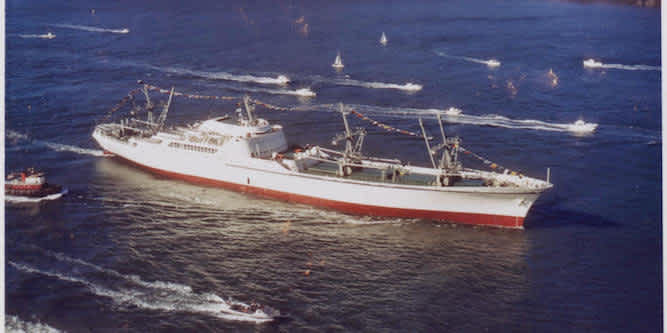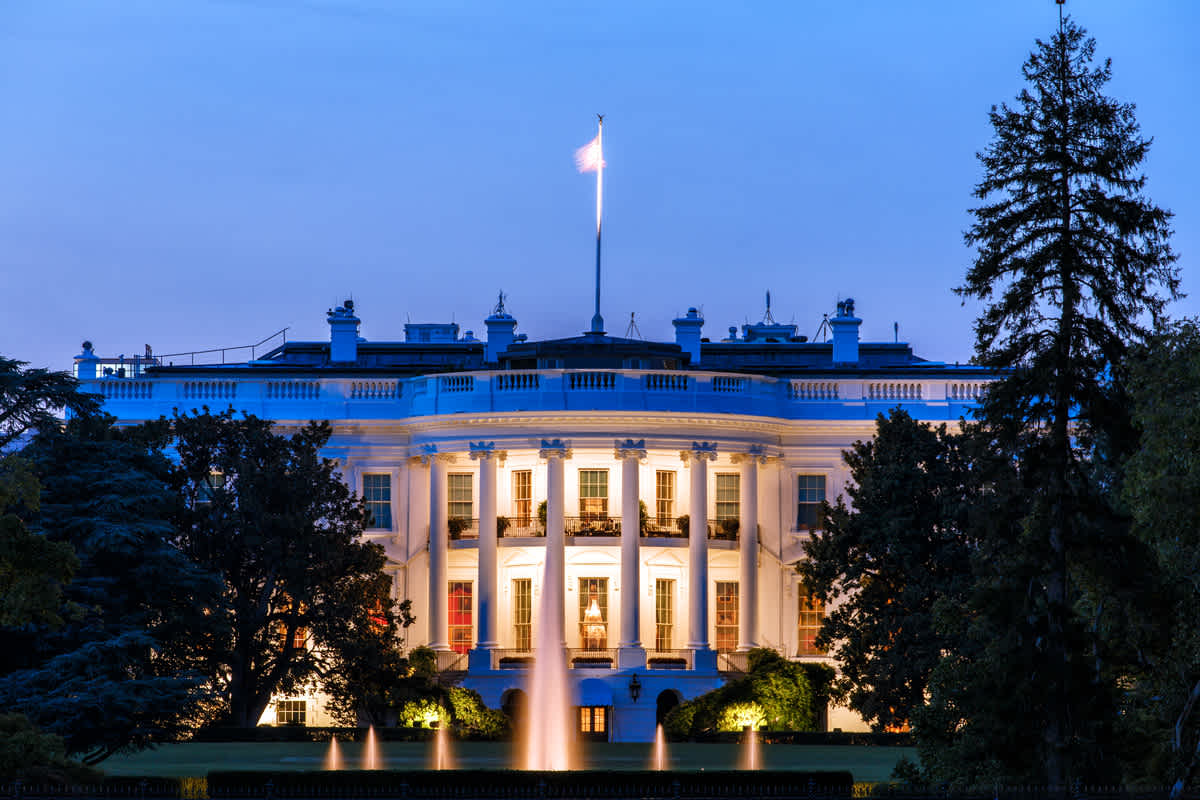
December 2, 2015
When America Dreamed of a Nuclear-Powered Cargo Fleet
When America Dreamed of a Nuclear-Powered Cargo Fleet
(Photo of the NS Savannah heading into San Francisco Bay. Image via Flickr Creative Commons.)
Nuclear-powered submarines, icebreakers, and aircraft carriers have been roaming the seas for decades. They were once joined by a small number of nuclear-powered merchant ships used to carry cargo.
Four countries have launched nuclear-powered merchant ships: America built the NS Savannah, a passenger-cargo ship; Germany built the Otto Hahn, which carried ore for nearly a decade; Japan built the Mutsu, which was decommissioned after a single test run; and Russia built the Sevmorput, which carried cargo until 2012.
America’s sole nuclear-powered cargo ship was one of the jewels of Eisenhower’s “Atoms for Peace” project. The NS Savannah was supposed to be the first of many American nuclear-powered merchant ships. She turned out to be the last.
This piece discusses the voyages of the Savannah, and the dream of a nuclear-powered merchant fleet that never was.
NS Savannah, America’s Only Nuclear-Powered Cargo Ship
How does a nuclear-powered ship work? In simple terms, conventional ships use diesel-powered engines (burning bunker fuel) to drive turbines; nuclear-powered ships drive the turbine with energy from a nuclear reactor. Instead of storing large and fluctuating quantities of fuel, a nuclear-powered ship uses a central, internally-constrained storage and consumption system. In the ‘50s, the world was enthralled by the idea of an inexpensive, thimble-sized amount of nuclear material powering a ship.
President Dwight Eisenhower announced the building of a “peace ship” in 1955. He proposed a civilian maritime ambassador as part of his Atoms for Peace project. Eisenhower wanted the ship to be a combination passenger and cargo vessel to demonstrate the application of nuclear propulsion to commerce. The Savannah was the result, completed and launched four years later.
She was expensive. The final cost was $47 million then, which is approximately $400 million in 2015. To put that in perspective, today’s largest ships, the Triple-E class, cost $185 million and can handle about 19 times more tonnage. The Savannah was designed as a diplomatic prototype to prove the viability of nuclear powered ships for civilian purposes. The administration declared to Congress: “The President seeks no return on this vessel except the goodwill of men everywhere… Neither will the vessel be burdened by proving itself commercially feasible by carrying goods exclusively.”
The Savannah was a marvel for passengers. She cut bold lines and looked like a luxury yacht. Her multiple staterooms all had private baths and were air conditioned. One of the decks had a swimming pool and her lounge doubled as a movie theatre. She sailed quietly, and her white surface was never blemished by exhaust smoke. Her dining hall seated 75 people, and featured a large mural sculpted by Pierre Bourdelle called “Fission.”

Dining room of the Savannah, with “Fission” on the right of the picture. Image via Wikimedia Commons.
Nuclear-powered ships are supposed to have less need to refuel. The Savannah fulfilled that promise: She was capable of circling the planet 14 times at 20 knots without needing more uranium. All this was accomplished while she emitted no greenhouse gases.
She made her maiden transatlantic voyage in 1964 to four European ports: Bremerhaven, Hamburg, Dublin, and Southampton. Over 150,000 people toured the vessel. She largely met Eisenhower’s public relation goals, showing the world that nuclear power could be used peacefully and demonstrating that nuclear-powered ships were safe.
She was not a success, however, in proving that nuclear ships were viable for commerce.
The Savannah’s public relations mission compromised her function as a cargo ships. She could handle 8,500 tons of cargo, while other cargo ships at the time could handle several times more. Her streamlined hull made it difficult to load the forward hulls. Most importantly, she was an advanced breakbulk ship that was built just as the entire industry was to be upended by the container revolution.
She met initial trouble in dealing with nuclear waste. The ship was designed to contain 10,000 gallons of liquid radioactive waste, but the capacity was often overwhelmed. In her first year she had to release more than 115,000 gallons of low-level radioactive water into the sea.
There were more problems related to the ship’s economics. The civilian nuclear industry wasn’t ready to support the ship. Although the Savannah needed little refueling, doing so was always costly: Given that there was only one nuclear-powered ship, it didn’t make sense to build ports with facilities for accepting nuclear waste and refueling with uranium. Her crew needed special training, and had to be a third larger than similarly-sized vessels. Given the lack of economies of scale, as well as the design compromises made to support the ship’s public relations mission, the Savannah had little hope of being commercially viable.
The vessel was decommissioned in 1971, after eight years of loss-making service. The Savannah has been designated a National Historic Landmark and is now docked as a museum ship at Pier 13 in Baltimore. She’s open to the public; you can make a visit.
The Economics of a Nuclear-Powered Merchant Fleet
The Savannah was never meant to be a profit-making commercial operation. Instead, she was a political project initiated by Eisenhower to generate goodwill towards nuclear energy and the United States. Unfortunately for Eisenhower, she has become a symbol for the idea that nuclear-powered cargo ships have no future. Instead of being the first in a new era of marvelous ships, she turned out to be a capstone for a different age.
The nuclear-powered merchant ships of other countries offered mixed results. Germany’s Otto Hahn (named for the Nobel prize winner who discovered nuclear fission in 1938), was a more cost-effective carrier of ore, but she was still decommissioned after only nine years of service. The Russian Sevmorput put in over 20 years of service without incident, and may be re-activated to explore the Arctic. The Japanese Matsu suffered the worst fate. In a sea trial in 1974, she started leaking radiation into the sea. Local fishermen blocked her return to port for nearly two months because they feared radiation.
The objections against nuclear-powered ships are numerous and well-founded. It could be catastrophic if any of them sank or leaked waste into the sea. Terrorists could find few targets more enticing. They’re a nightmare to insure. There are few ports with facilities that can accept nuclear waste and offer refueling services. And it seems unlikely that the public would accept them any time soon; consider that both the Russian and the Japanese ships encountered popular opposition that wouldn’t allow them to dock.

Nuclear icebreaker Yamal, by Christopher Michel, via Wikimedia Commons
Still, let’s take a speculative bent and consider the other side. What are some of the benefits of a merchant fleet that has a greater reliance on nuclear power?
Consider the reason that there are nuclear-powered vessels in the first place. Aircraft carriers want to be able to travel at high speeds over long distances; submarines need to stay submerged for long periods without refueling; and icebreakers need to operate in Arctic conditions without fuel supplies. Having a traveling nuclear reactor solves those problems.
The modern ships that deliver our goods are even larger than these vessels. Indeed, container ships are the biggest mobile superstructures ever made; some are larger than the Empire State Building if it were laid on the ground. Nuclear reactors make sense especially for vessels with high power requirements like container ships. Nuclear-powered container ships would benefit from being able to travel more quickly, having more space to carry goods instead of fuel, and having less need to refuel.
More importantly, consider its effects on pollution. Just 15 of the world’s biggest ships may emit as much pollution as all the world’s cars. Nuclear-powered ships emit no CO2 or greenhouse gas. Replacing just a few of the biggest ships with nuclear reactors would make a significant dent in air and ocean pollution. This is especially relevant with the emergence of a trade route in the Arctic. When ships go through, it’s much better that they don’t run on diesel. Nuclear vessels reduce the amount of Arctic melt induced by soot.
Consider finally that the economics of the Savannah had a better chance of working out if she were left to operate a while longer. The 1973 Oil Crisis erupted only one year after her decommissioning. Rod Adams, an atomic energy expert, calculates that a ship of the Savannah’s capacity would have seen fuel costs nearly quadruple, from a daily cost of $2,400 to $9,000. The operating disadvantages of the Savannah would have significantly disappeared if she were allowed to sail in that environment. Oil prices aren’t always going to be low, and commercial uranium has become a fairly inexpensive fuel.
It’s hard to definitely say that the economics can work out, given that a nuclear-powered cargo fleet can only be scaled with a large investment in civilian infrastructure. We can be more confident though in saying that there would be fewer greenhouse emission if more diesel ships ran on nuclear.
The United States has never had a nuclear reactor accident on its submarines and aircraft carriers.
The timing of the NS Savannah was unfortunate. She was a breakbulk ship in an age that was rapidly moving towards massive container ships. And she was decommissioned just as she could have become economical from an energy standpoint. In a cruel twist, her status as a political goodwill project was used to defeat her case as a viable commercial venture. But that doesn’t mean that the idea of a nuclear-powered cargo fleet ought to be one entirely relegated to history.




